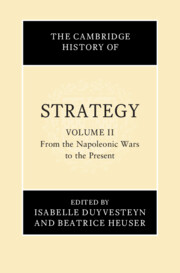Book contents
- The Cambridge History of Strategy
- The Cambridge History of Strategy
- The Cambridge History of Strategy
- Copyright page
- Dedication
- Contents
- Maps
- Contributors to Volume II
- Preface and Acknowledgements
- Introduction to Volume II
- 1 The Strategies of the Napoleonic Wars
- 2 Guerrilla and Nineteenth-Century Strategies of Insurgency
- 3 Russia, 1877–1917
- 4 The American Civil War
- 5 The Use of Naval Power
- 6 The Russo-Japanese War
- 7 Chinese Strategy, 1926–1949
- 8 First World War
- 9 Soviet Strategy, 1917–1945
- 10 Air Power
- 11 The Second World War in Europe
- 12 The Second World War in the Asia–Pacific
- 13 Soviet Strategy, 1945–1989
- 14 People’s War and Wars of Decolonisation
- 15 Nuclear Strategies
- 16 America’s Way of War
- 17 The Korean War
- 18 Israel’s Wars
- 19 The India–Pakistan Confrontations
- 20 The Yugoslav War, 1991–1999
- 21 Terrorism and Insurgency
- 22 The Forty-Year War in Afghanistan
- 23 The Three Gulf Wars and Iraq
- 24 China’s Wars, 1950–2021
- Conclusion
- Further Reading
- Index
19 - The India–Pakistan Confrontations
Published online by Cambridge University Press: 06 January 2025
- The Cambridge History of Strategy
- The Cambridge History of Strategy
- The Cambridge History of Strategy
- Copyright page
- Dedication
- Contents
- Maps
- Contributors to Volume II
- Preface and Acknowledgements
- Introduction to Volume II
- 1 The Strategies of the Napoleonic Wars
- 2 Guerrilla and Nineteenth-Century Strategies of Insurgency
- 3 Russia, 1877–1917
- 4 The American Civil War
- 5 The Use of Naval Power
- 6 The Russo-Japanese War
- 7 Chinese Strategy, 1926–1949
- 8 First World War
- 9 Soviet Strategy, 1917–1945
- 10 Air Power
- 11 The Second World War in Europe
- 12 The Second World War in the Asia–Pacific
- 13 Soviet Strategy, 1945–1989
- 14 People’s War and Wars of Decolonisation
- 15 Nuclear Strategies
- 16 America’s Way of War
- 17 The Korean War
- 18 Israel’s Wars
- 19 The India–Pakistan Confrontations
- 20 The Yugoslav War, 1991–1999
- 21 Terrorism and Insurgency
- 22 The Forty-Year War in Afghanistan
- 23 The Three Gulf Wars and Iraq
- 24 China’s Wars, 1950–2021
- Conclusion
- Further Reading
- Index
Summary
Independent India developed a three-tiered approach to its grand strategy: first, dealing with the challenges of national integration and threats on its immediate periphery from Pakistan and the People’s Republic of China (PRC); second, carving a role for itself as a significant actor in the emergence of a recently decolonised Asia; third, attempting to shape the post-war global order through ideational means. It was able, to a very considerable extent, to achieve its first goal although it failed to secure its Himalayan border with the PRC and suffered a disastrous military defeat in 1962. Its second objective ultimately failed to materialise, largely because of flawed strategies and domestic constraints. The final aim met with very partial success. It played an outsized role in promoting decolonisation, had a limited impact on global disarmament negotiations and made minor contributions to the peaceful resolution of international disputes. Until the end of the Cold War, while India’s stated strategic goals mostly remained the same, it lacked the material capabilities and requisite moral authority to influence key developments in global politics. Only with renewed economic growth, growing military clout and an expanded diplomatic presence has India now become a more influential actor in global politics. However, domestic political choices may undermine the realisation of all three goals.
- Type
- Chapter
- Information
- The Cambridge History of Strategy , pp. 387 - 410Publisher: Cambridge University PressPrint publication year: 2025

